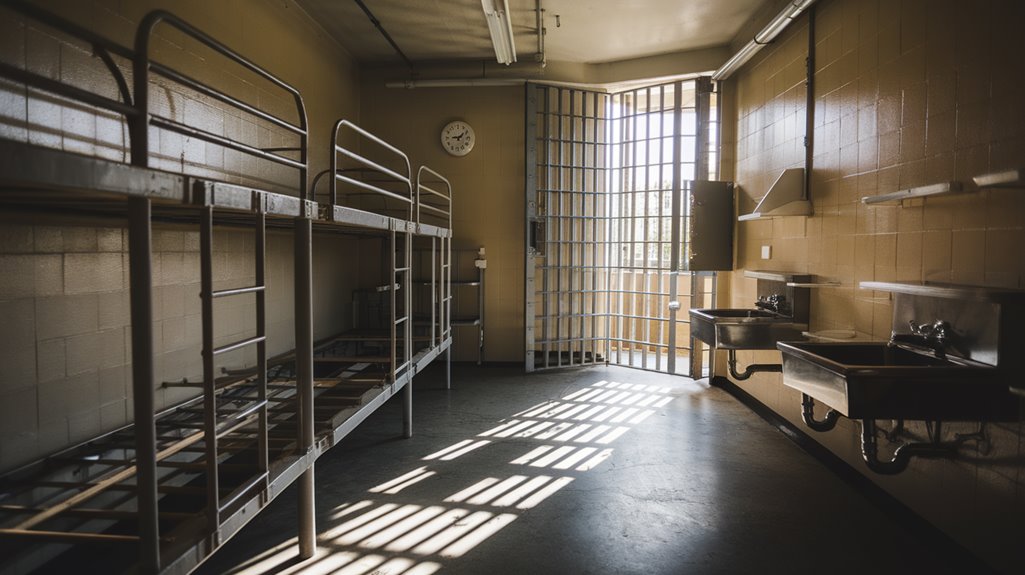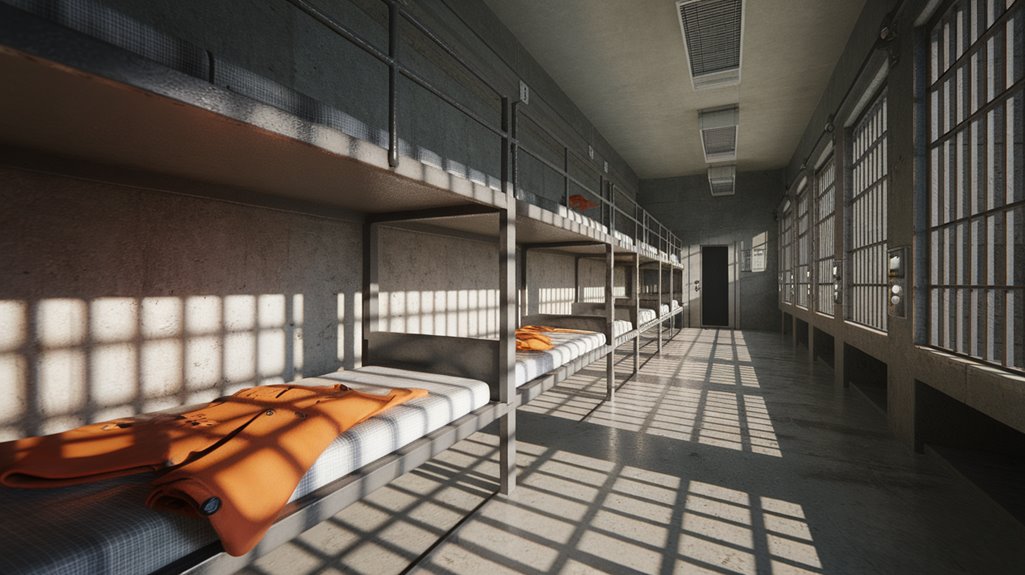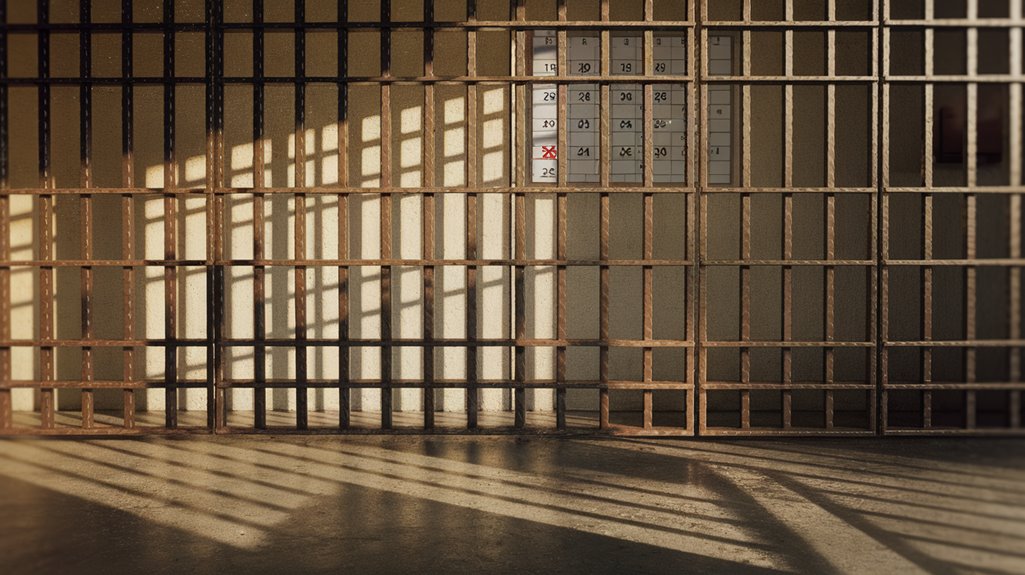A custody day in California's jail system counts as any portion of a 24-hour period spent in confinement, starting at arrest. Both full and partial days qualify for credit. The basic "day-for-day" credit system applies to various detention types, including jail time and work release programs. Pre-sentence custody follows a "2-for-4" formula, while post-sentence custody typically earns one credit per day served. Understanding these nuances helps maximize credit potential.
Key Takeaways
- A custody day in California begins at arrest and includes both full and partial days of confinement in jail.
- Pre-sentence custody time earns credits at a 2:4 ratio, meaning two days of good behavior earns four days credit.
- Each calendar day in custody earns at least one basic credit day, regardless of the time of admission or release.
- Work release programs and other detention forms count as custody days for credit calculation purposes.
- Credit calculation includes both actual days served plus conduct credits, following specific formulas based on custody dates.
Basic Definition of a Custody Day

A custody day represents the basic unit of time credit in California's jail system. Under current custody definitions, the time calculation begins on the arrest date and continues until sentencing. The system counts both full and partial days of confinement.
Credit implications extend to various forms of detention, including regular jail time and work release programs. The first day of confinement counts as one full credit day, though most jurisdictions do not include the actual sentencing date in the total. This credit system applies to both misdemeanor and felony cases, though specific rules may vary based on the type of conviction.
Pre-sentence incarceration directly reduces the length of the final sentence under PC 4019, providing inmates with tangible benefits for time served before their official sentencing date.
Pre-Sentencing Vs Post-Sentencing Credits
California's jail credit system operates in two distinct phases: pre-sentencing credits earned while awaiting court proceedings and post-sentencing credits accumulated after conviction. Pre-sentencing credits follow a "2-for-4" formula where inmates earn two days credit for every four days served, while post-sentencing credits in state prison generally allow one day of credit for each day served plus additional conduct credits. The timing of incarceration matters greatly, as enhanced credit-earning rules vary between county jails and state prisons, with different rates applying to misdemeanors versus felonies.
Credit Calculation Time Periods
Two distinct time periods affect how jail credits are calculated in California. The first period covers pre-sentencing time, when defendants are in custody before their case concludes. The second period includes post-sentencing time, after the court has imposed a final sentence.
Credit accumulation rates differ between these periods. Before January 2010, pre-sentence custody duration earned credits at a 2:6 ratio. This changed to a more favorable 2:4 ratio after January 2010, except for serious felons and sex offenders. After October 2011, even these exclusions were eliminated.
Post-sentencing credits follow different rules. State prison inmates typically earn one day of credit per six months served, while county jail inmates maintain the 2:4 ratio established in 2011.
Qualifying Time Behind Bars
Determining which jail time qualifies for credits requires understanding two key periods. Pre-sentencing credits apply to time spent in custody before a case concludes, while post-sentencing credits cover detention after sentencing.
For pre-sentencing time, inmates earn 2 days of conduct credit for every 4 days in actual custody. However, strict eligibility criteria limit who can receive these credits. Those with prior serious felonies, violent offenses, or sex registration requirements are excluded from qualifying offenses.
Post-sentencing credits follow the same 2:4 ratio as pre-sentence time. These apply universally to all inmates serving county jail sentences after October 1, 2011. The system rewards good behavior during both periods, though pre-sentence rules have more restrictions on who can earn credits.
Enhanced Credit Earning Rules
The credit earning system for jail time follows different rules before and after sentencing. During pre-sentencing, inmates earn credits at a 4:1 ratio – two days for actual custody plus two days for good behavior. This means for every two days served, they can earn four days total credit.
Post-sentencing credit earning strategies vary based on eligibility criteria. Some inmates qualify for 20% credit (earning 1 day per 4 served), while others may receive up to 66.6% (earning 2 days per 1 served). The rates depend on offense type and behavior.
Key restrictions apply under PC 4019. Violent felonies, sex offenses with minors, and forced labor cases face limited credits. Work release participants can earn conduct credits, while rule violations may result in credit forfeiture.
Credit Calculation Methods
Several distinct methods exist for calculating jail credits in California. The system uses both actual time served and good behavior credits to determine total custody credits. Credit calculation methods vary based on the type of facility and timing of the offense.
Key aspects of credit calculations include:
- One partial day counts as a full day under PC 2900.5
- County jails allow 2-for-2 day credits for good behavior
- State prisons provide 6-month credits per 6 months served
- Pre-2010 offenses earn credits at different rates
- Serious/violent felonies have restricted credit earnings
The jail credit implications differ markedly between county and state facilities. County inmates typically earn credits at a rate that reduces sentences by half, while state prisoners follow a different formula based on offense timing and classification.
Different Types of Custody Arrangements

California recognizes multiple custody arrangements to accommodate diverse family situations. The two main types are joint custody and sole custody, which can apply to both legal and physical custody rights.
Joint custody allows both parents to share decision-making responsibilities for their child's education, healthcare, and welfare. In contrast, sole custody grants one parent complete authority over major decisions. Physical custody determines where the child lives. With joint physical custody, children spend significant time with both parents. Sole physical custody means the child primarily lives with one parent.
Courts can also issue temporary custody orders during emergencies or pending litigation. These arrangements provide immediate stability while permanent custody decisions are being made. Emergency orders typically last until a hearing, while temporary orders may extend for several months.
Enhanced Credit Opportunities
California inmates can boost their credit earnings through work programs and fire camp participation. Nonviolent offenders in fire camps can earn up to 66.6% credits, while other minimum-custody nonviolent prisoners qualify for 50% credits. These enhanced opportunities encourage rehabilitation and positive behavior while helping reduce prison populations.
Work Program Credit Multipliers
Inmates who participate in qualified work programs can earn enhanced credit multipliers toward their sentences. The basic work program benefits include earning up to 1.5 days of credit for each day of participation. Credit multiplier eligibility depends on several key factors:
- Continuous participation in approved programs
- No violent felony convictions (capped at 15%)
- Clean disciplinary record
- Determinate sentence status
- Active program availability
The credit system prioritizes inmates with good behavior records to accelerate their release. Monthly accounting guarantees credits don't exceed statutory limits. Work assignments range from in-custody projects to community labor. Counties may vary in how they apply rates and caps. GPS monitoring tracks work furlough participation in high-risk areas. Credits can be forfeited for infractions or unauthorized program withdrawal.
Non-Violent Offense Bonuses
Nonviolent offenders can earn significant time reductions through enhanced credit programs in California jails and prisons. The standard earning rate for these inmates is 66.6% daily credit, which doubles the typical 50% rate. This creates strong nonviolent offense incentives for good behavior and program participation.
Credit earning strategies include multiple paths to accelerate release. Inmates can earn Milestone Completion Credits through education and training programs. Those who participate in fire camps receive additional 66.6% credits while helping with wildfire prevention. Post-secondary education can yield up to 100% additional credits. Under Proposition 57, nonviolent offenders may also qualify for parole after completing their primary term, provided they maintain good conduct and avoid disciplinary violations.
Impact of Prior Convictions

Prior convictions can markedly limit a person's jail credit eligibility in California. The impact of prior convictions creates several key restrictions on credit eligibility, especially for those with violent felony histories.
Key credit eligibility restrictions include:
- Violent felony convictions trigger PC §2933.1 credit prohibitions
- Two prior violent felonies tried separately activate three-strikes limitations
- Murder convictions permanently bar credits under PC §2933.2
- Pre-2011 sex offender registrants faced automatic disqualification
- Serious felony priors nullified credits before 2011 reforms
Recent legislation has softened some restrictions. AB 109 Realignment relaxed credit caps for non-violent three-strikers. SB 1200 removed credit denials for juvenile priors. Courts must now explicitly justify credit denials based on prior convictions.
Multiple Charges and Credit Distribution
Beyond the impact of prior convictions, California's jail credit system faces added complexity when multiple charges come into play. The system must handle multiple charge overlap situations where inmates serve time for different offenses simultaneously.
When custody periods overlap for separate charges stemming from the same conduct, inmates can receive concurrent credit eligibility. This means they earn credits for multiple cases during the same time period. The rules change based on whether charges are state or federal, violent or non-violent. For consecutive sentences, credits apply separately to each term. With concurrent sentences, credits earned during overlapping periods get distributed proportionally across all charges. This creates a detailed accounting process to guarantee proper credit allocation while maintaining fairness in the system.
Special Program Credit Considerations

California inmates can earn additional credits through approved work release programs based on their participation and compliance. Mental health treatment programs offer Milestone Completion Credits of 1-6 weeks upon successful completion of therapeutic goals. Both work release and mental health programs require institutional approval and good behavior to maintain earned credits.
Work Release Credit Rules
Several key rules govern work release credit eligibility in California's jail system. Inmates must work 35+ hours weekly and be within 120 days of release to qualify. The program excludes those with violent crimes, sex offenses, or arson convictions.
Key work release requirements include:
- Maintaining gainful employment
- No previous forced escapes
- No drug-related offenses
- Following county work schedules (8-10 hours daily)
- Meeting public interest criteria for nonprofit work
Credits are earned at a rate of one custody day per 8 work hours. The system allows program participation to substitute for work hours. Educational, vocational, and substance abuse programs count toward credit earning. All calculations follow the post-2017 CDCR rules, with credits applied uniformly across county facilities.
Mental Health Program Credits
The mental health program credit system adds specialized options for incarcerated individuals with psychological needs. Through programs like Enhanced Outpatient Program (EOP) and Developmentally Disabled Program (DDP), participants can earn credit for therapeutic activities.
| Program Type | Weekly Hours | Credit Earned | Max Annual Credit |
|---|---|---|---|
| EOP/DDP | 60 hours | 1 week | 6 weeks |
| Inpatient | 60 hours | 1 week | 6 weeks |
| POC | Variable | Based on plan | 6 weeks |
| ISMIP | Variable | Based on plan | 6 weeks |
Participants must complete 60 hours weekly of structured mental health benefits like group therapy and case management. No partial credit is given. The Mental Health Chief validates all credits within 10 business days. Credits can reduce parole terms and help access housing support after release.
Legal Framework for Credit Determination
Legal provisions governing jail credit in California establish clear guidelines for calculating time served. The framework defines credit eligibility based on custody duration, with one day counted as any full 24-hour period from arrest to release.
Key elements of credit determination include:
- Each calendar day earns at least one day of actual custody credit
- Conduct credits vary based on custody dates (pre/post January 2010)
- Time must be split between actual custody and conduct credit
- Special rules apply for state prison commitments
- Different formulas exist for misdemeanors versus felonies
The system underwent significant changes in 2010, shifting from a one-third reduction to a one-half reduction for conduct credits. Post-2020 reforms further modified the framework by eliminating certain exclusions for felony categories, making the system more uniform across offense types.
Time Computation Guidelines

Computing jail credits requires understanding specific calculation formulas and rates. The credit calculation system uses three main formulas based on different rates: Formula A provides 6 days credit for every 4 actual days served at a 15% rate, Formula B allows 4 days for every 2 actual days at 33.3%, and Formula C grants 1 credit day for each actual day at 50%.
To determine time credits, divide actual days by the formula's base number and multiply the quotient by two for Formulas A and B. Formula C simply matches actual days served. The total credit combines actual days served plus good conduct credits (GCC). Any remainders in calculations are dropped and not carried forward. This systematic approach guarantees consistent credit calculations across cases.
Credit Disqualification Factors
While inmates can earn jail credits for time served, certain factors can disqualify them from receiving these benefits. Multiple prior felony convictions and violent crimes are major credit disqualification reasons. Serious offenses like murder, rape, and related attempts automatically bar inmates from earning conduct credits.
Violent crimes and multiple felonies prevent inmates from receiving jail time credits, with serious offenses like murder barring all benefits.
The impact of infractions during incarceration can also affect credit eligibility:
- Murder-related conduct erases 180 days of credit permanently
- Lesser infractions result in up to 30-day credit loss
- Secure housing placement resets credit timelines
- Serious disciplinary issues lead to mandatory credit denial
- Non-serious infractions require clean conduct periods for restoration
Offenses involving deadly weapons, hostage-taking, or those resulting in death completely disqualify inmates from credit consideration. Proposition 57 specifically excludes inmates serving life sentences from retroactive credit applications.
Recent Changes in Credit Laws

California's jail credit laws have changed considerably since 2010. The credit law evolution began with inmates earning 2 days of conduct credit for every 6 days in custody. This changed on January 25, 2010, when enhanced credits allowed 2 days for every 4 days served in county jail.
The custody credit implications shifted again in September 2010, reverting to the original formula for county jails while state prison inmates received day-for-day credit on pre-sentence time. By October 2011, the Realignment Act standardized credits to 2 days per 4 days served for county jail terms. Throughout these changes, various exclusions were implemented for serious/violent felonies and sex offenses, marking significant reforms in how California calculates custody credits.
Record Keeping Requirements
Maintaining accurate records of jail credits requires strict adherence to documentation protocols. California courts must follow specific record keeping practices when calculating and documenting custody credits. The abstract of judgment serves as the primary document for tracking these credits.
Proper documentation of jail credits demands meticulous record keeping, with California courts relying on abstracts of judgment for accurate tracking.
Key documentation standards include:
- Separation of actual time and conduct credits
- Verification of signatures from legal officers
- Documentation of custody start and end dates
- Specification of credit calculation ratios
- Inclusion of all relevant agency affidavits
Courts collaborate with sheriffs and probation departments to guarantee accurate credit calculations. Each agency plays a role in verifying time served and conduct credits. The abstract must reflect both pre-sentence and post-sentence adjustments. Incomplete or unsigned documentation can lead to post-conviction relief claims and appellate errors. Proper documentation ensures that all adjustments are accurately recorded, reducing the risk of miscalculations. This is especially crucial in cases involving plea agreements in the Bay Area, where sentencing terms often rely on precise credit determinations. Failure to account for these details can result in delayed releases or legal challenges that burden the court system. Additionally, courts must remain vigilant in monitoring compliance with sentencing alternatives, including house arrest for DUI offenses, to ensure that defendants adhere to the terms set forth in their agreements. This oversight not only helps maintain public safety but also reinforces the integrity of the judicial process. By meticulously reviewing and updating records related to credit calculations and alternative sentences, all stakeholders can contribute to a more efficient legal system, ultimately benefiting both the defendants and the community at large. Moreover, a comprehensive approach to credit calculations not only fosters accountability among the agencies involved but also enhances the overall integrity of the judicial process. By understanding federal convictions in detail, stakeholders can better navigate the complexities of sentencing guidelines and the implications of various credits, which may differ significantly from state-level cases. This level of detail is essential for minimizing potential disputes and ensuring that justice is served promptly and fairly, as even minor discrepancies can exasperate systemic issues within the legal framework. Moreover, the accuracy of credit calculations is essential not only for maintaining the integrity of the justice system but also for ensuring that defendants receive fair treatment. In cases like house arrest for fifth DUI charges, the determination of earned credits can significantly impact the terms of confinement and the timeline for potential release. By prioritizing the accuracy and completeness of documentation, courts can minimize the likelihood of disputes and foster a more efficient legal process for all parties involved.
Frequently Asked Questions
Do Holidays and Weekends Count Differently for Jail Credit Calculations?
Holidays and weekends have no special impact on jail credit calculations. The system treats every calendar day equally, regardless of whether it falls on a holiday or weekend. Weekend calculations follow the same rules as weekdays, with no distinction made between different types of days. Credits accumulate continuously based on actual time served, and facility closures or special dates do not affect how custody time is counted.
Can Jail Credits Transfer Between Different Counties in California?
Over 85% of California counties now participate in automated credit transfer systems. Jail credits can transfer between different California counties through established jail credit policies and county collaboration networks. The process requires proper documentation from the original facility. Courts must honor pre-sentence credits when cases move between jurisdictions. While paperwork may take time, inmates don't lose earned credits during transfers as long as proper procedures are followed.
How Do Medical Furloughs Affect the Accumulation of Custody Credits?
Medical furloughs have a direct impact on custody credit calculations. Time spent on medical furlough does not count toward continuous incarceration periods. This means inmates do not earn custody credits while away from the facility for medical reasons. When they return, they can resume earning credits, but the furlough creates a gap in their credit accumulation timeline. Documentation and Department of Corrections approval are required for all medical furloughs.
What Happens to Earned Credits if Someone Is Wrongfully Convicted?
When someone is exonerated after a wrongful conviction, they typically retain credits earned during their imprisonment. Through innocence project advocacy, these individuals can petition CDCR for credit reinstatement using policy 3043(c). Credits remain valid unless specifically invalidated by court proceedings. Educational Merit Credits awarded after August 2017 can retroactively reduce their Youth Parole Eligibility Dates. However, credits may be denied if misconduct occurred during incarceration, even if wrongfully imprisoned.
Can Inmates Donate or Transfer Their Earned Credits to Other Inmates?
Like a personal bank account that only you can access, earned credits in California prisons cannot be shared or transferred between inmates. Behind the steel bars and concrete walls, each person's credits represent their individual journey toward rehabilitation. The system strictly prohibits inmate transfers of credits, as these rewards are tied directly to personal achievements through work, education, and good behavior. Credit sharing is not allowed under any circumstances.
Conclusion
Time behind bars ticks like a steady metronome, marking each precious day. California's jail credit system acts as a compass, guiding inmates through the maze of pre-sentencing and post-sentencing calculations. Like leaves on a tree, credits can multiply or fall away based on behavior and circumstances. Understanding these rules helps navigate the path to freedom, turning each marked day into a step closer to release.
